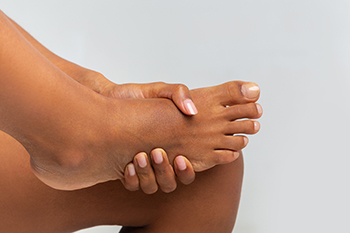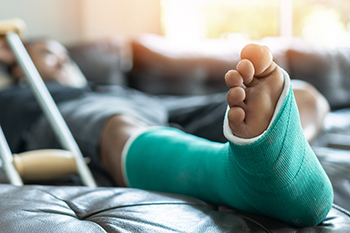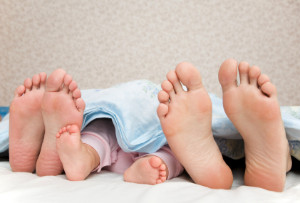Items filtered by date: May 2022
Athletes and Stress Fractures

A stress fracture is a common athletic injury. It often involves the long bones in the foot that are known as the metatarsal bones. When a stress fracture occurs, which is also referred to as a hairline fracture, it can cause pain and discomfort. It is often difficult to walk on the affected foot, and relief may come from elevating the foot. It can happen when runners increase their speed and distance too fast. Additionally, people who run for long distances at a time may experience a stress fracture. Wearing shoes that fit correctly may decrease the risk of getting this type of fracture. Some people have existing medical conditions that may increase the risk of getting a stress fracture. These can include osteoporosis, arthritis, diabetes, or a vitamin deficiency. A diagnosis is typically performed by having an X-ray taken, and then proper treatment measures are taken. If you feel you have a stress fracture, it is strongly suggested that you schedule an appointment with a podiatrist who can help you to manage this ailment.
Activities where too much pressure is put on the feet can cause stress fractures. To learn more, contact Patrick Bruton, DPM from Big Country foot and Ankle. Our doctor can provide the care you need to keep your pain free and on your feet.
Dealing with Stress Fractures of the Foot and Ankle
Stress fractures occur in the foot and ankle when muscles in these areas weaken from too much or too little use. The feet and ankles then lose support when walking or running from the impact of the ground. Since there is no protection, the bones receive the full impact of each step. Stress on the feet can cause cracks to form in the bones, thus creating stress fractures.
What Are Stress Fractures?
Stress fractures occur frequently in individuals whose daily activities cause great impact on the feet and ankles. Stress factors are most common among:
- Runners
- People affected with Osteoporosis
- Tennis or basketball players
- Gymnasts
- High impact workouts
Symptoms
Pain from the fractures occur in the area of the fractures and can be constant or intermittent. It will often cause sharp or dull pain with swelling and tenderness. Engaging in any kind of activity which involves high impact will aggravate pain.
If you have any questions please feel free to contact our offices located in Abilene, and Brownwood, TX . We offer the newest diagnostic and treatment technologies for all your foot and ankle needs.
Common Causes of a Broken Foot

One of the most common injuries, a broken foot, is characterized by worsening pain, bruising, and swelling. It is usually accompanied by a loss of feeling, a limited range of movement, and difficulty in bearing weight. Two of the top causes of a broken foot are severe impact in car accidents and trauma from dropping something heavy on the foot. Another common way to break or fracture the foot, especially among athletes, is kicking a ball. Sudden impact combined with running speed can increase the risk. It is also quite common to break your foot from a fall, especially down stairs or onto a particularly rigid surface. Both sports injuries and falling can result in a twisted ankle, which can mask the fact that a bone also has broken. Taking a wrong step, such as off a curb or ladder, can result in foot fractures. Underlying conditions, like arthritis, may also contribute to the risk. Wearing shoes that lack proper stability and support, such as high heels, may cause a loss of balance or a fall that leads to a broken foot. Repetitive impact, common to runners and joggers, is a common cause of stress fractures in the feet. If you believe you have broken your foot, please seek immediate care from a podiatrist.
A broken foot requires immediate medical attention and treatment. If you need your feet checked, contact Patrick Bruton, DPM from Big Country foot and Ankle. Our doctor can provide the care you need to keep you pain-free and on your feet.
Broken Foot Causes, Symptoms, and Treatment
A broken foot is caused by one of the bones in the foot typically breaking when bended, crushed, or stretched beyond its natural capabilities. Usually the location of the fracture indicates how the break occurred, whether it was through an object, fall, or any other type of injury.
Common Symptoms of Broken Feet:
- Bruising
- Pain
- Redness
- Swelling
- Blue in color
- Numbness
- Cold
- Misshapen
- Cuts
- Deformities
Those that suspect they have a broken foot shoot seek urgent medical attention where a medical professional could diagnose the severity.
Treatment for broken bones varies depending on the cause, severity and location. Some will require the use of splints, casts or crutches while others could even involve surgery to repair the broken bones. Personal care includes the use of ice and keeping the foot stabilized and elevated.
If you have any questions please feel free to contact our offices located in Abilene, and Brownwood, TX . We offer the newest diagnostic and treatment technologies for all your foot and ankle needs.
Seniors and Falls

Everyone can stumble but older people have a higher propensity to falling. In fact, one in four seniors fall each year and the chances of falling double after falling once. Falls can be serious and cause broken bones or a head injury. They can greatly interfere with one’s ability to function and do so independently. Even if a fall is avoided, an older person can become fearful of falls and limit their participation in daily activities. This can further lead to weakness and increased chances of falling. Physical conditions that can make one more prone to falling include lower body weakness, vitamin D deficiency, difficulty with walking or balance, use of certain medications, vision problems, and foot pain. Other issues that lead to a greater risk of falls are poorly fitting footwear or home hazards, such as broken or uneven steps or throw rugs that can be tripped over. Tending to physical and other conditions, getting regular strength and balance exercise, and seeing a podiatrist for evaluation of risk for falling can help as well. As one ages, regular visits to a podiatrist are encouraged as a preventative health measure.
Preventing falls among the elderly is very important. If you are older and have fallen or fear that you are prone to falling, consult with Patrick Bruton, DPM from Big Country foot and Ankle. Our doctor will assess your condition and provide you with quality advice and care.
Every 11 seconds, an elderly American is being treated in an emergency room for a fall related injury. Falls are the leading cause of head and hip injuries for those 65 and older. Due to decreases in strength, balance, senses, and lack of awareness, elderly persons are very susceptible to falling. Thankfully, there are a number of things older persons can do to prevent falls.
How to Prevent Falls
Some effective methods that older persons can do to prevent falls include:
- Enrolling in strength and balance exercise program to increase balance and strength
- Periodically having your sight and hearing checked
- Discuss any medications you have with a doctor to see if it increases the risk of falling
- Clearing the house of falling hazards and installing devices like grab bars and railings
- Utilizing a walker or cane
- Wearing shoes that provide good support and cushioning
- Talking to family members about falling and increasing awareness
Falling can be a traumatic and embarrassing experience for elderly persons; this can make them less willing to leave the house, and less willing to talk to someone about their fears of falling. Doing such things, however, will increase the likelihood of tripping or losing one’s balance. Knowing the causes of falling and how to prevent them is the best way to mitigate the risk of serious injury.
If you have any questions, please feel free to contact our offices located in Abilene, and Brownwood, TX . We offer the newest diagnostic and treatment technologies for all your foot care needs.
See Your Podiatrist Regularly If You Work On Your Feet
Children Can Experience Heel Pain Too

It may be difficult for you to know if your child is having heel pain, because it isn’t often associated with children. However, certain conditions that cause heel pain can afflict the young, even if they don’t know how to properly communicate their distress. Sever’s disease, for instance, is a form of heel pain that stems from irritation to the growth plate in the heels of growing children. Children can also develop plantar fasciitis from overuse of the heel or by wearing shoes that don’t fit. This condition is a painful inflammation of the plantar fascia tissue where it connects to the heel on the sole of the feet. Active children can also develop tiny stress fractures of the heel bone which can occur gradually over time and be quite painful. There are certain clues your child’s condition may provide, if you know what to look for. If your child limps or changes the way they walk or run, cuts back on physical activities, complains that their feet or heels feel odd or stiff, or that something is stuck in their shoe, they may have a painful heel condition. It is suggested to make an appointment for your child with a podiatrist to have your child’s condition diagnosed and treated properly.
Making sure that your children maintain good foot health is very important as they grow. If you have any questions, contact Patrick Bruton, DPM of Big Country foot and Ankle. Our doctor can provide the care you need to keep you pain-free and on your feet.
Keeping Children's Feet Healthy
Having healthy feet during childhood can help prevent medical problems later in life, namely in the back and legs. As children grow, their feet require different types of care. Here are some things to consider...
Although babies do not walk yet, it is still very important to take care of their feet.
Avoid putting tight shoes or socks on his or her feet.
Allow the baby to stretch and kick his or her feet to feel comfortable.
As a toddler, kids are now on the move and begin to develop differently. At this age, toddlers are getting a feel for walking, so don’t be alarmed if your toddler is unsteady or ‘walks funny’.
As your child gets older, it is important to teach them how to take care of their feet.
Show them proper hygiene to prevent infections such as fungus.
Be watchful for any pain or injury.
Have all injuries checked by a doctor as soon as possible.
Comfortable, protective shoes should always be worn, especially at play.
If you have any questions please feel free to contact our offices located in Abilene, and Brownwood, TX . We offer the newest diagnostic and treatment technologies for all your foot and ankle needs.
Several Forms of Ankle Pain

Ankle pain can be sharp or dull depending on the type of injury that has occurred. While some patients have pain from ankle sprains or strains, ankle pain can come from arthritis as well. An Achilles tendon injury can cause severe ankle pain and can happen from an injury that overstretches this strong band of tissue that connects the calf muscle to the heel bone. Symptoms of a fractured ankle can include swelling surrounding the ankle, and it is often difficult to walk. Soft tissue damage can come from an ankle sprain or strain and can cause significant pain. Additionally, the medical condition that is known as gout can cause ankle pain, and it is necessary to have immediate treatment. If you have ankle pain for any reason, please consult with a podiatrist as quickly as possible so the correct treatment can begin.
Ankle pain can have many different causes and the pain may potentially be serious. If you have ankle pain, consult with Patrick Bruton, DPM from Big Country foot and Ankle. Our doctor will assess your condition and provide you with quality foot and ankle treatment.
Ankle pain is any condition that causes pain in the ankle. Due to the fact that the ankle consists of tendons, muscles, bones, and ligaments, ankle pain can come from a number of different conditions.
Causes
The most common causes of ankle pain include:
- Types of arthritis (rheumatoid, osteoarthritis, and gout)
- Ankle sprains
- Broken ankles
- Achilles tendinitis
- Achilles tendon rupture
- Stress fractures
- Tarsal tunnel syndrome
- Plantar fasciitis
Symptoms
Symptoms of ankle injury vary based upon the condition. Pain may include general pain and discomfort, swelling, aching, redness, bruising, burning or stabbing sensations, and/or loss of sensation.
Diagnosis
Due to the wide variety of potential causes of ankle pain, podiatrists will utilize a number of different methods to properly diagnose ankle pain. This can include asking for personal and family medical histories and of any recent injuries. Further diagnosis may include sensation tests, a physical examination, and potentially x-rays or other imaging tests.
Treatment
Just as the range of causes varies widely, so do treatments. Some more common treatments are rest, ice packs, keeping pressure off the foot, orthotics and braces, medication for inflammation and pain, and surgery.
If you have any questions, please feel free to contact our offices located in Abilene, and Brownwood, TX . We offer the newest diagnostic and treatment technologies for all your foot care needs.

